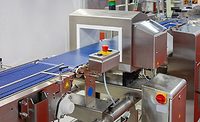How is the Revolution in Technology Changing Food Safety?
How has adoption of different technologies affected processors' daily food safety operations and improved their food safety outcomes?

Image credit: Kondor83/iStock/Getty Images Plus via Getty Images
Technology has affected every aspect of our daily lives—and food safety is no exception. Over the past few Food Safety Insights columns, we have discussed the changes that have been seen over the past 20 years since the introduction of rapid microbiological test methods. These tests, which were designed to simplify testing and produce faster test results, certainly achieved those goals, but they also ushered in many more changes by improving plant efficiency and increasing throughput. These improvements precipitated changes in logistics and need for inventory. They also helped drive laboratories out of food plants and rapidly accelerated the growth of the commercial food safety laboratory market. As in many areas of technology, a few developments helped change the entire landscape of the market.
However, "technology" comes in many forms, and it is not just testing technology that has and will continue to change the food safety landscape. An entire host of other technological applications have been applied to the food safety field over the past few decades.
Let me confess to a pet peeve that I have about the use of the word "technology." In today's lexicon, "technology" too often refers only to "computers and internet-related" technology. While these technologies have certainly changed our daily lives, technology is more than just computers. One definition of the word "technology" is "the application of scientific knowledge for practical purposes, especially in industry." With this definition in mind, it is clear that many types of technologies have made tremendous advances in recent decades. So, for this series of columns on technology, although there will be many mentions of computer-related and especially database technology, we will claw back some of the recognition from computers and look at many different types of technologies.
Processor Adoption of Technology: Survey Results
Since technology has driven many advances in food safety, we wanted to find out more about how your adoption of different technologies has affected your food safety operations, and how that has changed your daily operations and improved your food safety outcomes.
In March 2024, we surveyed approximately 200 food processors from 38 countries around the world and heard more about what technologies they have adopted and what that has meant for their daily operations.
We started by asking if processors had adopted any new laboratory and/or processing technologies over the past 5–10 years. As seen in Figure 1 and Figure 2, respectively, more than half of the survey respondents reported that they had adopted a new processing technology, but fewer than half reported using a new laboratory technology.
For processing technologies, the most common answers were new X-ray and metal detection technologies (Figure 3). Several respondents mentioned that not only had they implemented new X-ray systems and/or metal detectors, but they also thought that these two technologies had made the most impact on food safety improvements over the past 5–10 years. Several mentioned that the installation of better X-ray machines has completely eliminated their instances of bone fragments making their way into final products.
One poultry processor said, "The addition of automated deboning machines for leg deboning has had the greatest impact. We have had major volume increases without needing to add as many staff personnel as would have been needed with hand deboning. We have been able to greatly lower the incidence rate of bone in finished materials."
A manufacturer of meat snacks mentioned, "X-ray inspection on the packaging lines has pretty much eliminated bone pieces being sent out to the general public."
I will say that when we asked that question, we expected that the top responses would be about computers and database technologies. However, as reported by the U.S. Department of Agriculture (USDA), recalls in 2023 for the presence of extraneous materials accounted for the third-largest volume of recalled product, and more than twice as many recalls and roughly five times the product volume recalled as for contamination with Listeria monocytogenes or Shiga toxin-producing Escherichia coli (STEC). Furthermore, these statistics only account for recalls, not additional losses of extraneous material-containing product detected and destroyed at the plant. It should not be a surprise that technologies like X-ray systems and metal detectors can have a significant impact on food safety and processor business efficiency.
Technology Adoptions During and After COVID-19
We asked another question that we were very curious to hear respondents' opinions on. With everything that happened during the COVID-19 pandemic, there was much discussion about how COVID-19 was going to "change everything." While some permanent changes are clearly evident—work-from-home, virtual meetings, better attention to handwashing and sanitation—when we asked about technologies that were adopted during the pandemic that remain in use, more than half of the survey respondents (and close to 80 percent in the U.S. and Canada) reported that the adaptations they made to cope with COVID-19 had not become permanent changes (Figure 4).
The most commonly reported changes that were made permanent were largely related to employee hygiene. Many people reported that they made changes to their employee hygiene practices and installed automatic handwashing machines that remained in place. They also reported continuing to have a higher use of alcohol-based sanitizers. Others reported maintaining reduced crowding on processing lines and other employee spacing and hygienic practices that they adopted for line workers, including specific training and practices based on risk for different sections of the processing line. A few mentioned that they have maintained use of head scanners for temperature checks.
Many also mentioned that they continue to employ remote work, training, inspections, and audits, and better electronic recordkeeping to reduce the amount of paperwork that might be a factor for cross-contamination.
I did learn an interesting and unexpected aspect of remote meetings that I had not considered before. In an interview with a food safety specialist at a processor in South Africa, she told me that the increase in remote meetings had greatly enabled her to keep up with developments in food safety and maintain her continuing education in the field. She explained that as South Africa is quite distant to cities in North America, Europe, and East Asia where many conferences and meetings are typically held, traveling to those meetings can be prohibitively time-consuming and expensive. Following COVID-19, when most conferences were virtual, many have remained virtual or at least retained a hybrid format with a virtual option. She pointed out that far more of these conferences are now accessible to her because of these changes, and she is able to attend presentations and training events more easily and more often to keep her skills and knowledge current.
For those of us located close to larger cities in Europe, North America, or other regions of the world where events are frequently held, it may be easy to overlook how relatively convenient conference attendance can be. However, the availability of virtual options for meetings and conference attendance can bring those benefits to more people in more areas of the world.
If it is true that "every dark cloud has a silver lining," and if the pandemic drove us to pay better attention to employee hygiene and plant sanitation and a democratization of training and food safety information, then perhaps that is our silver lining.
Next Issue
We learned much more about processors' adoption of different technologies and the impact this is having on their food safety outcomes, and we will bring you those details in our next Food Safety Insights column in the August/September issue.
We will discuss the use and adoption of the next most-popular technologies mentioned in our survey, including computer and database technologies, lower detection levels of analytical technology in chemistry and microbiology (including whole genome sequencing), and automated electronic visual inspection technologies. We will also look at opinions on where advances in technology are still needed for better outcomes in, for example, controlling food fraud, improving traceability, reducing fungal and mold issues, better detection of allergens, and many others.
Bob Ferguson is President of Strategic Consulting Inc. and can be reached at bobferguson9806@gmail.com or on X/Twitter at @SCI_Ferguson.
Looking for a reprint of this article?
From high-res PDFs to custom plaques, order your copy today!






